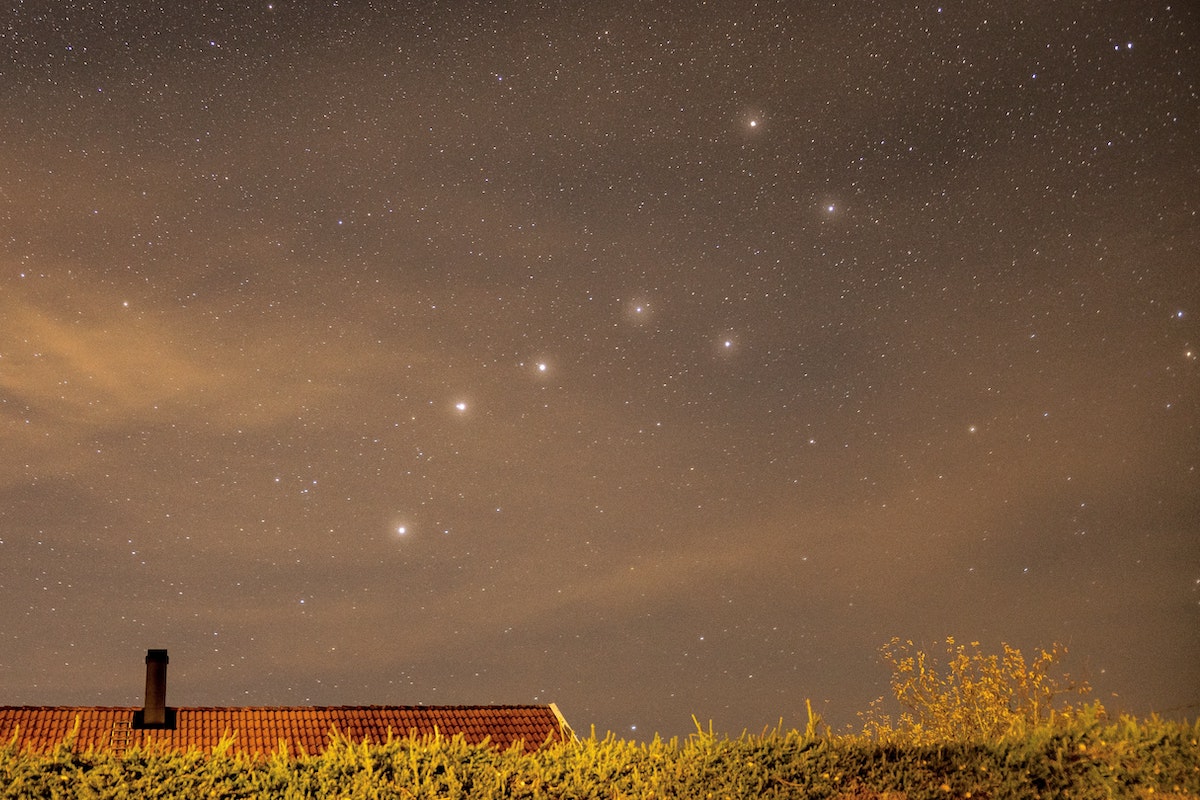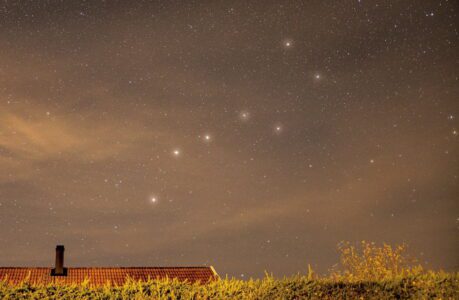Ursa Major, also known as the Great Bear, is one of the most prominent and recognizable constellations in the night sky. It is visible from the northern hemisphere throughout the year, and has been studied and admired by humans for thousands of years. In this article, we’ll explore the history, mythology, notable features, and how to spot Ursa Major in the sky.
History and Mythology
Ursa Major has been recognized and named by many cultures throughout history, from ancient Greek and Roman mythology to Native American folklore. The constellation is often associated with bears or other large mammals, due to its resemblance to a bear’s shape. The ancient Greeks believed that Ursa Major represented the mother of Zeus, Callisto, who was turned into a bear by Hera as punishment for her affair with Zeus. In some Native American legends, the seven brightest stars in Ursa Major represent a bear who was chased into the sky by hunters.
Notable Features
Ursa Major contains several notable stars and deep sky objects that are worth exploring. The most famous is the Big Dipper, which is made up of the seven brightest stars in the constellation. The Big Dipper is often used as a navigational tool, as the two stars on the edge of the “bowl” point towards the North Star. The North Star, also known as Polaris, is not actually part of Ursa Major, but is located close enough that it can be used as a reference point for finding the constellation.
Other notable features in Ursa Major include several galaxies, including the Whirlpool Galaxy (M51) and the Pinwheel Galaxy (M101), as well as the Owl Nebula (M97) and the Cigar Galaxy (M82). These objects can be viewed with a telescope or binoculars, and offer stunning views of our universe.
How to Spot Ursa Major
Ursa Major is a circumpolar constellation, meaning it can be seen year-round in the northern hemisphere. It is best viewed in the spring and summer months, when it is high in the sky and most visible. To find Ursa Major, look for the Big Dipper, which is located in the “head” of the bear. Follow the two stars on the edge of the “bowl” towards the North Star, and you will see the rest of the constellation.
Conclusion
Ursa Major is a beautiful and fascinating constellation that has captured the imaginations of people for centuries. Its history, mythology, and notable features make it a rewarding object to explore with the naked eye or with telescopes and binoculars. Whether you are an experienced astronomer or simply enjoy stargazing, taking the time to explore Ursa Major can offer a glimpse into the vastness and wonder of our universe.
The stars in Ursa Major
Ursa Major, also known as the Great Bear, is a constellation in the northern hemisphere that is easily recognizable due to its distinctive shape. The constellation contains several bright stars that are visible to the naked eye, as well as numerous fainter stars and deep sky objects that can be seen with telescopes or binoculars.
The seven brightest stars in Ursa Major form the Big Dipper, which is one of the most recognizable asterisms in the night sky. The stars in the Big Dipper are named after their positions in the constellation and are designated as follows:
- Alkaid (Eta Ursae Majoris): the star at the end of the “handle” of the Big Dipper
- Mizar (Zeta Ursae Majoris): the second star from the end of the “handle” of the Big Dipper
- Alioth (Epsilon Ursae Majoris): the star at the end of the “bowl” of the Big Dipper farthest from the handle
- Megrez (Delta Ursae Majoris): the star at the end of the “bowl” of the Big Dipper closest to the handle
- Phecda (Gamma Ursae Majoris): the star on the side of the “bowl” of the Big Dipper opposite Megrez
- Merak (Beta Ursae Majoris): the star on the side of the “bowl” of the Big Dipper opposite Dubhe
- Dubhe (Alpha Ursae Majoris): the star at the end of the “handle” of the Big Dipper farthest from the “bowl”
While the stars in the Big Dipper are the most famous in Ursa Major, the constellation contains many other stars of varying brightness. Some of the brightest stars in Ursa Major outside of the Big Dipper include:
- Talitha (Iota Ursae Majoris): a binary star system consisting of a yellow-white giant and a blue-white dwarf
- Tania Australis (Mu Ursae Majoris): a binary star system consisting of two white stars
- Tania Borealis (Lambda Ursae Majoris): a white star that is slightly brighter than Tania Australis
- Alula Borealis (Nu Ursae Majoris): a binary star system consisting of two white stars
- Alula Australis (Xi Ursae Majoris): a binary star system consisting of a yellow-white giant and a white dwarf
In addition to stars, Ursa Major also contains several notable deep sky objects, including galaxies and nebulae. Some of the most famous objects in Ursa Major include the Whirlpool Galaxy (M51), the Pinwheel Galaxy (M101), the Owl Nebula (M97), and the Cigar Galaxy (M82). These objects can be viewed with telescopes or binoculars and offer breathtaking views of our universe.
Deep sky objects in Ursa Major
Ursa Major, also known as the Great Bear, is a constellation that contains several fascinating deep sky objects, including galaxies and nebulae. These objects are visible with telescopes or binoculars and offer spectacular views of the universe. Here are some of the notable deep sky objects in Ursa Major:
The Whirlpool Galaxy (M51)
This stunning spiral galaxy is located about 23 million light years from Earth and is named for its swirling appearance. It is a popular target for amateur astronomers due to its bright core and well-defined spiral arms. The Whirlpool Galaxy is also notable for its interaction with its companion galaxy, which has caused intense star formation in the region.
The Pinwheel Galaxy (M101)
Another spiral galaxy in Ursa Major, the Pinwheel Galaxy is located about 21 million light years from Earth. It is one of the largest and brightest galaxies in the Messier catalogue and can be seen with binoculars in dark skies. The Pinwheel Galaxy is known for its prominent spiral arms and high rate of star formation.
The Cigar Galaxy (M82)
This irregular galaxy is located about 12 million light years from Earth and is known for its unique shape, which resembles a cigar. The Cigar Galaxy is a starburst galaxy, which means it is experiencing a burst of intense star formation. It is also one of the brightest infrared sources in the sky, due to the dust and gas in the galaxy absorbing visible light and emitting infrared radiation.
The Owl Nebula (M97)
Also known as the “Little Ghost Nebula,” this planetary nebula is located about 2,030 light years from Earth. It is named for its resemblance to an owl’s head and eyes when viewed through a telescope. The Owl Nebula is created when a dying star sheds its outer layers, which are illuminated by the central star’s remaining core.
The Leo I Dwarf Galaxy
While not technically part of Ursa Major, the Leo I Dwarf Galaxy is a nearby satellite galaxy that is gravitationally bound to Ursa Major. It is one of the faintest galaxies visible with amateur telescopes and is notable for its high concentration of dark matter. The Leo I Dwarf Galaxy is also home to a large population of ancient stars, which can provide insights into the early history of the universe.
These deep sky objects in Ursa Major offer a glimpse into the vastness and beauty of our universe. They are just a few of the many fascinating objects waiting to be explored in the night sky.
Why is Ursa Major important
Ursa Major, also known as the Great Bear, is an important constellation for several reasons. Here are some of the ways in which Ursa Major is significant:
Navigation
The stars in Ursa Major, particularly those in the Big Dipper asterism, have been used for navigation for thousands of years. The two stars on the edge of the “bowl” of the Big Dipper point towards the North Star, which can be used as a reference point for finding direction. In addition, the Big Dipper can be used to find other stars and constellations in the sky.
Culture and Mythology
Ursa Major has been recognized and named by many cultures throughout history, from ancient Greek and Roman mythology to Native American folklore. It is often associated with bears or other large mammals, due to its resemblance to a bear’s shape. The constellation has played a role in many stories, legends, and rituals across different cultures and time periods.
Astronomy
Ursa Major is home to several notable deep sky objects, including galaxies and nebulae. These objects provide insights into the formation and evolution of the universe and offer opportunities for scientific discovery and exploration. The Whirlpool Galaxy, Pinwheel Galaxy, Cigar Galaxy, and Owl Nebula are just a few of the fascinating objects located in Ursa Major.
Inspiration
Ursa Major, like many other constellations, has inspired and captured the imaginations of people for centuries. Its beauty and mystery have inspired art, music, literature, and scientific exploration. Ursa Major serves as a reminder of the vastness and wonder of the universe and the human desire to understand and appreciate it.
In summary, Ursa Major is important for its role in navigation, culture and mythology, astronomy, and inspiration. It is a symbol of the human fascination with the universe and our ongoing quest to explore and understand it.
When is Ursa Major visible from Ireland
Ursa Major, also known as the Great Bear, is visible from Ireland throughout the year. However, the visibility and position of Ursa Major in the sky will vary depending on the time of year and time of night.
In general, Ursa Major is easiest to see in the northern hemisphere during the spring and summer months. During these times, the constellation will be high in the sky and more visible for longer periods of time. In contrast, during the fall and winter months, Ursa Major will be closer to the horizon and may be more difficult to spot.
The best time to observe Ursa Major from Ireland will depend on your location, as well as factors such as weather and light pollution. In general, the best time to observe the night sky is during periods of clear, dark skies, away from city lights and other sources of light pollution.
To observe Ursa Major from Ireland, look for the Big Dipper asterism, which is made up of the seven brightest stars in the constellation. The two stars on the edge of the “bowl” of the Big Dipper point towards the North Star, which can be used as a reference point for finding direction. Ursa Major can be seen with the naked eye, but may be easier to observe with binoculars or a telescope.
Overall, Ursa Major is visible from Ireland throughout the year, but its visibility and position in the sky will vary depending on several factors. With the right conditions and location, Ursa Major can provide a beautiful and rewarding sight for stargazers in Ireland.

